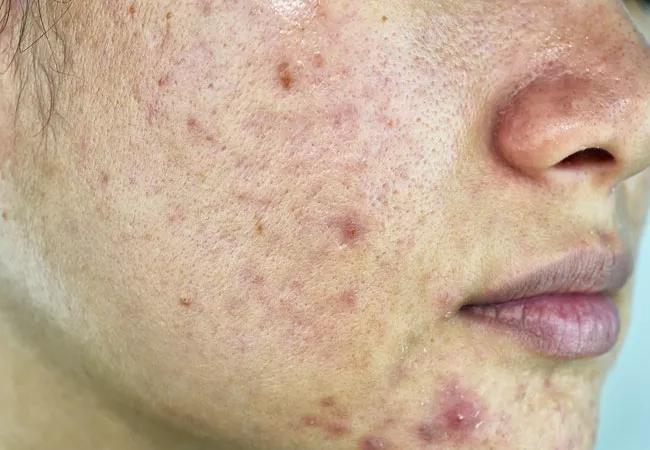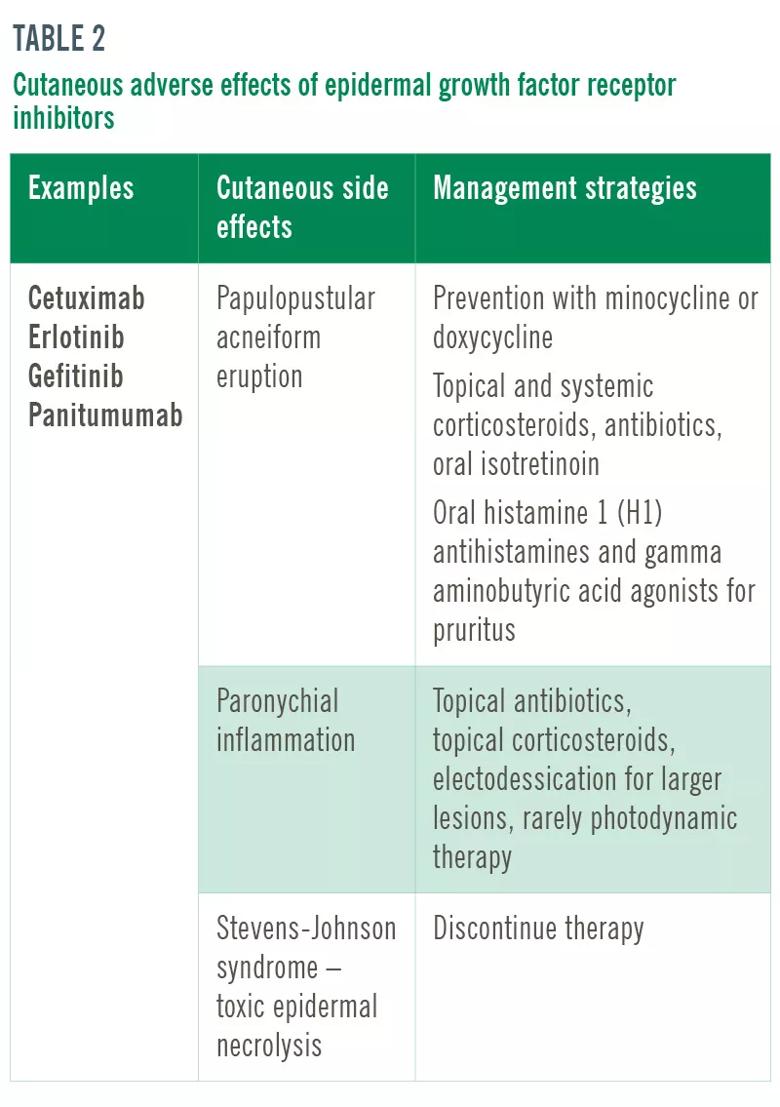by Anthony Fernadez, MD, and Christie Warren, MD
Advertisement
Cleveland Clinic is a non-profit academic medical center. Advertising on our site helps support our mission. We do not endorse non-Cleveland Clinic products or services. Policy
Note: This is an abridged version of an article originally published in the Cleveland Clinic Journal of Medicine.
Biologic therapies have revolutionized medicine and offer targeted therapy for an increasing number of diseases, particularly in rheumatology, gastroenterology, hematology/oncology and dermatology. But along with these advances and their ensuing expanded use have come many unique adverse effects.
Some of the most commonly reported adverse effects with these new therapies are cutaneous, and can potentially limit the use of these agents and add cost to already expensive treatment regimens.1
It is important for physicians and other healthcare providers to be aware of these effects, have a basic understanding of how to manage patients with these reactions, and to know when to refer to a dermatologist. This is the second article in a four-part series that reviews recent literature on cutaneous adverse reactions experienced with commonly prescribed biologic and targeted therapies.
Epidermal growth factor receptor (EGFR) is a transmembrane glycoprotein that, when activated, leads to the autophosphorylation of tyrosine kinase receptor, initiating a cascade of downstream signaling pathways involved in regulating cellular proliferation, differentiation and survival. EGFR inhibitors block this pathway in tumor cells and are predominantly used in non-small cell lung cancer, colorectal cancer, pancreatic cancer, and head and neck cancer. Examples include gefitinib, cetuximab, erlotinib and panitumumab.
Acneiform reactions
The most common cutaneous reaction with EGFR inhibitors is a widespread papulopustular acneiform eruption consisting of erythematous follicle-based papules and pustules without comedones.
More than half of patients taking these drugs experience an acneiform eruption. It is usually mild or moderate but can be severe in a minority of cases. The acneiform eruption is often dose-dependent and begins within one week of treatment.17
The lesions commonly present on the face and trunk, spare the palms and soles, and are associated with pruritus.
While management depends on the severity, consultation with a dermatologist is recommended for most patients, particularly if the reaction lasts more than two weeks or is severe. Prevention can include medications, such as minocycline or doxycycline. Treatment can include topical and systemic corticosteroids, antibiotics and oral isotretinoin. If there is pruritus, oral histamine 1 (H1) antihistamines can be used. Gamma aminobutyric acid agonists such as gabapentin and pregabalin can be used as second-line treatments for itching.
Toenail inflammation
A study of 10 patients suggested paronychial inflammation, commonly with pyogenic granuloma-like lesions, as another cutaneous manifestation.18 Paronychia in the great toe often occurs first, and secondary bacterial infection (commonly Staphylococcus aureus) can occur as well.
Treatment with topical antibiotics, topical corticosteroids, electrodessication for larger lesions, and, more rarely, photodynamic therapy, can be effective.
Other reactions
EGFR inhibitors have also been associated with hair changes including development of brittle, fine and curly hair on the scalp and extremities.
Xerosis with desquamation, small aphthous ulcerations of the oral and nasal mucosa, photosensitivity and urticaria have also been noted.
Cases of Stevens-Johnson syndrome-toxic epidermal necrolysis have been associated with erlotinib therapy, but the incidence is low.19 Discontinuation is recommended if any sign of a bullous or exfoliative eruption occurs.
References
- Treudler R. New drug therapies and their effect on the skin. J Dtsch Dermatol Ges. 2009; 7(7):623–637.
- Steenholdt C, Svenson M, Bendtzen K, Thomsen O, Brynskov J, Ainsworth M. Severe infusion reactions to infliximab: aetiology, immunogenicity and risk factors in patients with inflammatory bowel disease. Aliment Pharmacol Ther. 2011; 34(1):51–58.
- AbbVie, Inc. HUMIRA (adalimumab) injection, for subcutaneous use. Highlights of prescribing information. www.accessdata.fda.gov/drugsatfda_docs/label/2017/125057s399lbl.pdf. Accessed April 7, 2020.
- Capogrosso Sansone A, Mantarro S, Tuccori M, et al. Safety profile of certolizumab pegol in patients with immune-mediated inflammatory diseases: a systematic review and meta-analysis. Drug Saf. 2015; 38(10):869–888.
- Fréling E, Baumann C, Cuny JF, et al. Cumulative incidence of, risk factors for, and outcome of dermatological complications of anti-TNF therapy in inflammatory bowel disease: a 14-year experience. Am J Gastroenterol. 2015; 110(8):1186–1196.
- Hernández MV, Sanmartí R, Cañete JD, et al; BIOBADASER 2.0 Study Group. Cutaneous adverse events during treatment of chronic inflammatory rheumatic conditions with tumor necrosis factor antagonists: study using the Spanish registry of adverse events of biological therapies in rheumatic diseases. Arthritis Care Res (Hoboken). 2013; 65(12):2024–2031.
- Mocci G, Marzo M, Papa A, Armuzzi A, Guidi L. Dermatological adverse reactions during anti-TNF treatments: focus on inflammatory bowel disease. J Crohns Colitis. 2013; 7(10):769–779.
- Kane S, Khatibi B, Reddy D. Higher incidence of abnormal Pap smears in women with inflammatory bowel disease. Am J Gastroenterol. 2008; 103(3):631–636.
- George LA, Gadani A, Cross RK, Jambaulikar G, Ghazi LJ. Psoriasiform skin lesions are caused by anti-TNF agents used for the treatment of inflammatory bowel disease. Dig Dis Sci. 2015; 60(11):3424–3430.
- Mazloom SE, Yan D, Hu JZ, et al. TNF-a inhibitor-induced psoriasis: a decade of experience at the Cleveland Clinic. J Am Acad Dermatol. 2018. doi:10.1016/j.jaad.2018.12.018. Epub ahead of print.
- Li SJ, Perez-Chada LM, Merola JF. TNF inhibitor-induced psoriasis: proposed algorithm for treatment and management. J Psoriasis Psoriatic Arthritis. 2019; 4(2):70–80.
- Cleynen I, Van Moerkercke W, Billiet T, et al. Characteristics of skin lesions associated with anti-tumor necrosis factor therapy in patients with infl ammatory bowel disease: a cohort study. Ann Intern Med. 2016; 164(1):10–22.
- Ramos-Casals M, Brito-Zerón P, Soto MJ, Cuadrado MJ, Khamashta MA. Autoimmune diseases induced by TNF-targeted therapies. Best Pract Res Clin Rheumatol. 2008; 22(5):847–861.
- Mariette X, Matucci-Cerinic M, Pavelka K, et al. Malignancies associated with tumour necrosis factor inhibitors in registries and prospective observational studies: a systematic review and meta-analysis. Ann Rheum Dis. 2011; 70(11):1895–1904.
- Scott FI, Mamtani R, Brensinger CM, et al. Risk of nonmelanoma skin cancer associated with the use of immunosuppressant and biologic agents in patients with a history of autoimmune disease and nonmelanoma skin cancer. JAMA Dermatol 2016; 152(2):164–172.
- Mercer LK, Askling J, Raaschou P, et al. Risk of invasive melanoma in patients with rheumatoid arthritis treated with biologics: results from a collaborative project of 11 European biologic registers. Ann Rheum Dis. 2017; 76(2):386–391.
- Fabbrocini G, Panariello L, Caro G, Cacciapuoti S. Acneiform rash induced by EGFR inhibitors: review of the literature and new insights. Skin Appendage Disord. 2015; 1(1):31–37.
- Busam KJ, Capodieci P, Motzer R, Kiehn T, Phelan D, Halpern AC. Cutaneous side-effects in cancer patients treated with the antiepidermal growth factor receptor antibody C225. Br J Dermatol. 2001; 144(6):1169–1176.
- Jatoi A, Nguyen PL. Do patients die from rashes from epidermal growth factor receptor inhibitors? A systematic review to help counsel patients about holding therapy. Oncologist. 2008; 13(11):1201– 1204.
- Druker BJ, Talpaz M, Resta DJ, et al. Effi cacy and safety of a specific inhibitor of the BCR-ABL tyrosine kinase in chronic myeloid leukemia. N Engl J Med. 2001; 344(14):1031–1037.
- Kantarjian H, Sawyers C, Hochhaus A, et al; International STI571 CML Study Group. Hematologic and cytogenetic responses to imatinib mesylate in chronic myelogenous leukemia. N Engl J Med. 2002; 346(9):645–652.
- Heidary N, Naik H, Burgin S. Chemotherapeutic agents and the skin: an update. J Am Acad Dermatol. 2008; 58(4):545–570.
- Kantarjian H, Giles F, Wunderle L, et al. Nilotinib in imatinib-resistant CML and Philadelphia chromosome-positive ALL. N Engl J Med. 2006; 354(24):2542–2551.
- Cortes JE, Kantarjian HM, Brümmendorf TH, et al. Safety and efficacy of bosutinib (SKI-606) in chronic phase Philadelphia chromosomepositive chronic myeloid leukemia patients with resistance or intolerance to imatinib. Blood. 2011; 118(17):4567–4576.
- Abdel-Rahman O, Fouad M. Risk of mucocutaneous toxicities in patients with solid tumors treated with sunitinib: a critical review and meta analysis. Expert Rev Anticancer Ther. 2015; 15(1):129–141.
- Strumberg D, Awada A, Hirte H, et al. Pooled safety analysis of BAY 43-9006 (sorafenib) monotherapy in patients with advanced solid tumours: is rash associated with treatment outcome? Eur J Cancer. 2006; 42(4):548–556.
- Arnault JP, Wechsler J, Escudier B, et al. Keratoacanthomas and squamous cell carcinomas in patients receiving sorafenib. J Clin Oncol. 2009; 27(23):e59–e61.
- Sternberg CN, Davis ID, Mardiak J, et al. Pazopanib in locally advanced or metastatic renal cell carcinoma: results of a randomized phase III trial. J Clin Oncol. 2010; 28(6):1061–1068.
- Fischer A, Wu S, Ho AL, Lacouture ME. The risk of hand-foot skin reaction to axitinib, a novel VEGF inhibitor: a systematic review of literature and meta-analysis. Invest New Drugs. 2013; 31(3):787–797.
- Wells SA Jr, Gosnell JE, Gagel RF, et al. Vandetanib for the treatment of patients with locally advanced or metastatic hereditary medullary thyroid cancer. J Clin Oncol. 2010; 28(5):767–772.
- Hsiao YW, Lin YC, Hui RC, Yang CH. Fulminant acneiform eruptions after administration of dovitinib in a patient with renal cell carcinoma. J Clin Oncol. 2011; 29(12):e340–e341.
- Chapman PB, Hauschild A, Robert C, et al; BRIM-3 Study Group. Improved survival with vemurafenib in melanoma with BRAF V600E mutation. N Engl J Med. 2011; 364(26):2507–2516.
- Ascierto PA, Minor D, Ribas A, et al. Phase II trial (BREAK-2) of the BRAF inhibitor dabrafenib (GSK2118436) in patients with metastatic melanoma. J Clin Oncol. 2013; 31(26):3205–3211.
- Blechman AB, Cabell CE, Weinberger CH, et al. Aggressive skin cancers occurring in patients treated with the Janus kinase inhibitor ruxolitinib. J Drugs Dermatol. 2017; 16(5):508–511.
- Guan M, Zhou YP, Sun JL, Chen SC. Adverse events of monoclonal antibodies used for cancer therapy. Biomed Res Int. 2015; 2015:428169.
- Vila AT, Puig L, Fernández-Figueras MT, Laiz AM, Vidal D, Alomar A. Adverse cutaneous reactions to anakinra in patients with rheumatoid arthritis: clinicopathological study of fi ve patients. Br J Dermatol. 2005; 153(2):417–423.
- Rocchi V, Puxeddu I, Cataldo G, et al. Hypersensitivity reactions to tocilizumab: role of skin tests in diagnosis. Rheumatology (Oxford). 2014; 53(8):1527–1529.
- Dika E, Ravaioli GM, Fanti PA, et al. Cutaneous adverse effects during ipilimumab treatment for metastatic melanoma: a prospective study. Eur J Dermatol. 2017; 27(3):266–270.
- Shen J, Chang J, Mendenhall M, Cherry G, Goldman JW, Kulkarni RP. Diverse cutaneous adverse eruptions caused by anti-programmed cell death-1 (PD-1) and anti-programmed cell death ligand-1 (PD-L1) immunotherapies: clinical features and management. Ther Adv Med Oncol. 2018; 10:1758834017751634.








